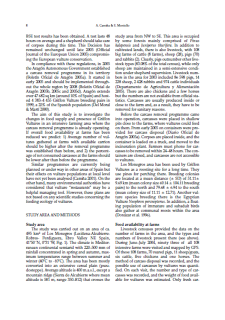- Search in all Repository
- Literature and maps
- Archeology
- Mills database
- Natural sciences
Advanced search
Advanced search
Advanced search
Advanced search
Advanced search

Object
Title: A comparison of two European breeding habitats of the water rail Rallus aquaticus
Creator:
Kroon, Gerard H. J. de ; Polska Akademia Nauk. Muzeum i Instytut Zoologii
Date issued/created:
Resource type:
Subtitle:
Acta Ornithologica, vol. 39, no. 1 ; Miejsca gniazdowe wodnika w różnych środowiskach ; Nest sites of water rail
Contributor:
Museum and Institute of Zoology, Polish Academy of Sciences
Publisher:
Place of publishing:
Description:
Bibliogr. p. 26 ; P. [21]-27 : il. ; 27 cm ; Abstract. pol.
Type of object:
Abstract:
The study was carried out in two sites fluvial mires (FM) in Netherlands, and at salt marshes (SM) and the borders of lagoons (BL) in Spain. All 58 nests were found in unmown and ungrazed vegetation. Carex species were dominant at the nesting sites in FM, but not Phragmites australis. Juncus maritimus was dominant in the SM and at BL. The plant communities at and around the nest sites of FM differed from those of SM+BL.At nest height from the side the nest was mostly only poorly visible. Nests at nest height and eggs at observer eye level were invisible among dense clusters of Juncus maritimus tussocks. Visibility of eggs in reed stands mixed with Carex species and in Sparganium erectum stands was mostly poor and moderate respectively. This was in contrast to nests situated among Juncus maritimus stems. Here, at eye-level the eggs were very conspicuous. For the most part, an incubating Water Rail on the nest at eye-level was hardly visible in any of the various stands. The vegetation height of nest sites in SM and BL was considerably less than in FM owing to the absence of Phragmites australis. The water depth at the nest sites varied. The nest height in tussocks of Juncus maritimus was greater. The nest material corresponded to the plant species in the immediate vicinity of the nest.
Relation:
Volume:
Issue:
Start page:
End page:
Detailed Resource Type:
Format:
Resource Identifier:
oai:rcin.org.pl:54205 ; click here to follow the link
Source:
MiIZ PAN, call no. patrz sygn. czas. P.257-39-1 ; MiIZ PAN, call no. patrz sygn. czas. P.4568-39-1 ; click here to follow the link
Language:
Rights:
Terms of use:
Copyright-protected material. May be used within the limits of statutory user freedoms
Digitizing institution:
Museum and Institute of Zoology of the Polish Academy of Sciences
Original in:
Library of the Museum and Institute of Zoology of the Polish Academy of Sciences
Projects co-financed by:
Programme Innovative Economy, 2010-2014, Priority Axis 2. R&D infrastructure ; European Union. European Regional Development Fund
Access:
Object collections:
- Repozytorium Cyfrowe Instytutów Naukowych > Kolekcje Partnerów > Muzeum i Instytut Zoologii PAN > Czasopisma
- Repozytorium Cyfrowe Instytutów Naukowych > Kolekcje Partnerów > Muzeum i Instytut Zoologii PAN > Wydawnictwa MiIZ PAN > Acta Ornithologica
- Repozytorium Cyfrowe Instytutów Naukowych > Piśmiennictwo > Czasopisma/Artykuły
Last modified:
Feb 4, 2025
In our library since:
Jun 10, 2015
Number of object content downloads / hits:
189
All available object's versions:
https://rcin.org.pl./publication/74026
Show description in RDF format:
Show description in RDFa format:
Show description in OAI-PMH format:
| Edition name | Date |
|---|---|
| A comparison of two European breeding habitats of the water rail Rallus aquaticus / Kroon, Gerard H. J. de. | Feb 4, 2025 |
Objects Similar
Burakowski, Bolesław Polska Akademia Nauk. Muzeum i Instytut Zoologii
Tomaszewska, K. Wioletta Polska Akademia Nauk. Muzeum i Instytut Zoologii
Iwan, Dariusz Polska Akademia Nauk. Muzeum i Instytut Zoologii
Warchałowski Andrzej Polska Akademia Nauk. Muzeum i Instytut Zoologii
Czeszczewik, Dorota Polska Akademia Nauk. Muzeum i Instytut Zoologii
Wysocki, Dariusz (1961– ) Polska Akademia Nauk. Muzeum i Instytut Zoologii
Tworek, Stanisław Polska Akademia Nauk. Muzeum i Instytut Zoologii
Randler, Christoph Polska Akademia Nauk. Muzeum i Instytut Zoologii

 INSTYTUT ARCHEOLOGII I ETNOLOGII POLSKIEJ AKADEMII NAUK
INSTYTUT ARCHEOLOGII I ETNOLOGII POLSKIEJ AKADEMII NAUK
 INSTYTUT BADAŃ LITERACKICH POLSKIEJ AKADEMII NAUK
INSTYTUT BADAŃ LITERACKICH POLSKIEJ AKADEMII NAUK
 INSTYTUT BADAWCZY LEŚNICTWA
INSTYTUT BADAWCZY LEŚNICTWA
 INSTYTUT BIOLOGII DOŚWIADCZALNEJ IM. MARCELEGO NENCKIEGO POLSKIEJ AKADEMII NAUK
INSTYTUT BIOLOGII DOŚWIADCZALNEJ IM. MARCELEGO NENCKIEGO POLSKIEJ AKADEMII NAUK
 INSTYTUT BIOLOGII SSAKÓW POLSKIEJ AKADEMII NAUK
INSTYTUT BIOLOGII SSAKÓW POLSKIEJ AKADEMII NAUK
 INSTYTUT CHEMII FIZYCZNEJ PAN
INSTYTUT CHEMII FIZYCZNEJ PAN
 INSTYTUT CHEMII ORGANICZNEJ PAN
INSTYTUT CHEMII ORGANICZNEJ PAN
 INSTYTUT FILOZOFII I SOCJOLOGII PAN
INSTYTUT FILOZOFII I SOCJOLOGII PAN
 INSTYTUT GEOGRAFII I PRZESTRZENNEGO ZAGOSPODAROWANIA PAN
INSTYTUT GEOGRAFII I PRZESTRZENNEGO ZAGOSPODAROWANIA PAN
 INSTYTUT HISTORII im. TADEUSZA MANTEUFFLA POLSKIEJ AKADEMII NAUK
INSTYTUT HISTORII im. TADEUSZA MANTEUFFLA POLSKIEJ AKADEMII NAUK
 INSTYTUT JĘZYKA POLSKIEGO POLSKIEJ AKADEMII NAUK
INSTYTUT JĘZYKA POLSKIEGO POLSKIEJ AKADEMII NAUK
 INSTYTUT MATEMATYCZNY PAN
INSTYTUT MATEMATYCZNY PAN
 INSTYTUT MEDYCYNY DOŚWIADCZALNEJ I KLINICZNEJ IM.MIROSŁAWA MOSSAKOWSKIEGO POLSKIEJ AKADEMII NAUK
INSTYTUT MEDYCYNY DOŚWIADCZALNEJ I KLINICZNEJ IM.MIROSŁAWA MOSSAKOWSKIEGO POLSKIEJ AKADEMII NAUK
 INSTYTUT PODSTAWOWYCH PROBLEMÓW TECHNIKI PAN
INSTYTUT PODSTAWOWYCH PROBLEMÓW TECHNIKI PAN
 INSTYTUT SLAWISTYKI PAN
INSTYTUT SLAWISTYKI PAN
 SIEĆ BADAWCZA ŁUKASIEWICZ - INSTYTUT TECHNOLOGII MATERIAŁÓW ELEKTRONICZNYCH
SIEĆ BADAWCZA ŁUKASIEWICZ - INSTYTUT TECHNOLOGII MATERIAŁÓW ELEKTRONICZNYCH
 MUZEUM I INSTYTUT ZOOLOGII POLSKIEJ AKADEMII NAUK
MUZEUM I INSTYTUT ZOOLOGII POLSKIEJ AKADEMII NAUK
 INSTYTUT BADAŃ SYSTEMOWYCH PAN
INSTYTUT BADAŃ SYSTEMOWYCH PAN
 INSTYTUT BOTANIKI IM. WŁADYSŁAWA SZAFERA POLSKIEJ AKADEMII NAUK
INSTYTUT BOTANIKI IM. WŁADYSŁAWA SZAFERA POLSKIEJ AKADEMII NAUK




































